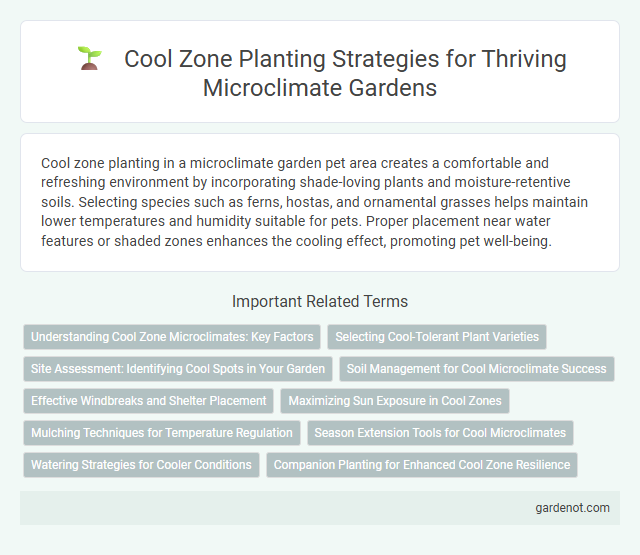Cool zone planting in a microclimate garden pet area creates a comfortable and refreshing environment by incorporating shade-loving plants and moisture-retentive soils. Selecting species such as ferns, hostas, and ornamental grasses helps maintain lower temperatures and humidity suitable for pets. Proper placement near water features or shaded zones enhances the cooling effect, promoting pet well-being.
Understanding Cool Zone Microclimates: Key Factors
Cool zone microclimates in garden settings are influenced primarily by factors such as shade availability, soil moisture retention, and wind protection, which collectively regulate temperature and humidity levels. Selecting plant species adapted to cooler conditions enhances growth and resilience, making native perennials and shade-tolerant shrubs ideal choices. Understanding the interplay of sunlight exposure, evaporation rates, and local topography is crucial for optimizing planting strategies in cool zone microclimates.
Selecting Cool-Tolerant Plant Varieties
Selecting cool-tolerant plant varieties for a microclimate garden's cool zone enhances resilience to lower temperatures and improves overall plant health. Species such as kale, spinach, and pansies thrive in cooler conditions, maintaining growth and aesthetic appeal during cold spells. Incorporating native and perennial plants adapted to local cool microclimates ensures sustainability and reduces maintenance efforts.
Site Assessment: Identifying Cool Spots in Your Garden
Site assessment for cool zone planting involves analyzing microclimates within your garden to identify naturally shaded or lower temperature areas. Factors such as tree canopy cover, soil moisture levels, and proximity to water features contribute to cooler spots ideal for heat-sensitive plants. Mapping these zones ensures strategic plant placement that maximizes growth and conserves water.
Soil Management for Cool Microclimate Success
Effective soil management is crucial for maintaining a cool microclimate in garden cool zones, emphasizing organic matter incorporation to enhance moisture retention and soil aeration. Mulching with natural materials such as straw or wood chips reduces soil temperature fluctuations and minimizes evaporation, promoting a stable root environment. Regular soil testing enables precise nutrient adjustments, supporting resilient plant growth and reinforcing the garden's cooling effects.
Effective Windbreaks and Shelter Placement
Strategic placement of dense evergreen shrubs and tall grasses creates effective windbreaks in microclimate gardens, significantly reducing wind speed and protecting delicate plants. Positioning shelter elements such as fences or pergolas on the windward side enhances microclimate stability by blocking harsh prevailing winds. These methods improve temperature regulation and moisture retention, fostering healthier plant growth in cool garden zones.
Maximizing Sun Exposure in Cool Zones
Maximizing sun exposure in cool zone planting involves selecting heat-loving plants like tomatoes, peppers, and basil, which thrive when placed in the sunniest sections of the garden. Positioning raised beds or containers on south-facing slopes or near reflective surfaces such as walls enhances light absorption and warmth. Using mulch and dark-colored materials around plants further retains heat, creating an optimal microclimate for growth in cooler environments.
Mulching Techniques for Temperature Regulation
Mulching techniques serve as a crucial method in cool zone planting to regulate soil temperature and maintain optimal moisture levels in microclimate gardens. Organic mulches like bark, straw, and compost not only insulate plant roots against temperature fluctuations but also improve soil structure and nutrient availability. Applying a 2-4 inch layer of mulch consistently reduces evaporation and prevents soil overheating, fostering healthier plant growth in cool microclimates.
Season Extension Tools for Cool Microclimates
Season extension tools such as row covers, cold frames, and hoop houses play a crucial role in enhancing plant growth in cool microclimates by protecting crops from frost and maintaining higher soil and air temperatures. Using these tools, gardeners can extend the growing season by several weeks, allowing for earlier planting in spring and prolonged harvests into fall. Strategic implementation of season extension techniques results in improved yield and healthier cool-season crops in microclimate garden zones.
Watering Strategies for Cooler Conditions
Cool zone planting in microclimate gardens requires precise watering strategies to maintain optimal soil moisture without overhydration. Implementing drip irrigation or soaker hoses minimizes evaporation, ensuring water reaches plant roots efficiently in cooler, shaded environments. Monitoring soil moisture levels regularly supports healthy plant growth while conserving water resources.
Companion Planting for Enhanced Cool Zone Resilience
Companion planting in cool zones enhances microclimate resilience by pairing plants that improve soil moisture retention and provide shade, reducing heat stress. Combining nitrogen-fixing legumes with deep-rooted vegetables promotes nutrient balance and boosts overall garden health. Strategic plant placement creates protective microhabitats that buffer temperature fluctuations and support biodiversity.
Cool zone planting Infographic

 gardenot.com
gardenot.com